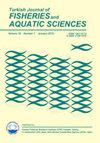微塑料出现在黑海大海鳗中的第一个证据(Syngnathus acus Linnaetabus,1758)
IF 1.7
4区 农林科学
Q3 FISHERIES
引用次数: 0
摘要
首次对黑海大管鱼(Syngnathus acus)体内的微塑料(MPs)含量进行了评估。在所有被检查的管鱼中,有21%被发现有MPs。MPs主要是形状(89%)、颜色(52%)和0.2- 1毫米(52%)的纤维。平均MP浓度为0.30 MP。鱼-1(考虑到所有分析过的鱼),1.38 mp。鱼-1(考虑到摄入它们的鱼)。雄性管鱼的MP发生率(23.5%)高于雌性(20.7%)和未成熟管鱼(16.7%)。91.7%的聚合物是人工合成的,其中聚对苯二甲酸乙二醇酯(PET)(29%)是最常见的聚合物。FTIR光谱也证实了塑料相关化合物,硬脂酸丁酯(BS)和甘油醛(GA)在分析样品中的存在。我们的研究结果表明,黑鲈是一种重要的生态底栖鱼类,在黑海受到了MPs的污染,迫切需要进行评估,以更好地了解黑海MPs的环境命运,并采取必要措施减少进入该盆地的塑料量。本文章由计算机程序翻译,如有差异,请以英文原文为准。
The First Evidence of Microplastics Occurrence in Greater Pipefish (Syngnathus acus Linnaetabus, 1758) in the Black Sea
Microplastics (MPs) occurrence in greater pipefish Syngnathus acus was assessed in the Black Sea for the first time. MPs were found in 21 % of total pipefish examined. MPs were mainly fibres in shape (89 %), black in colour (52 %) and 0.2- 1 mm (52 %) in size. The mean MP concentration was 0.30 mp. fish-1 (considering all the fish analysed) and was 1.38 mp. fish-1 (considering the fish that ingested them). The frequency of MP occurrence in male pipefish was higher (23.5 %) compared to females (20.7%) and immatures (16.7 %). 91.7 % of the polymers found were synthetic with the polyethylene terephthalate (PET) (29%) being the most common polymers. FTIR spectroscopy also confirmed the presence of the plastic-related compounds, butyl stearate (BS) and glyceraldehyde unnatural form (GA) in the analysed samples. Our results show that S. acus, which is an ecologically important demersal fish, is contaminated by MPs in the Black Sea and that there is an urgent assessment to better understand the environmental fate of MPs in the Black Sea and taking necessity measures to reduce the amount of plastics entering this basin.
求助全文
通过发布文献求助,成功后即可免费获取论文全文。
去求助
来源期刊

Turkish Journal of Fisheries and Aquatic Sciences
FISHERIES-MARINE & FRESHWATER BIOLOGY
CiteScore
3.10
自引率
0.00%
发文量
43
审稿时长
3 months
期刊介绍:
Turkish Journal of Fisheries and Aquatic Sciences" (TrJFAS) is a refereed academic journal has been published by Central Fisheries Research Institute of Turkey and Japan International Cooperation Agency (JICA), and published in English.
It aims to address research and needs of all working and studying within the many varied areas of fisheries and aquatic sciences.
The Journal publishes English language original research papers, critical review articles, short communications and technical notes on applied or scientific research relevant to freshwater, brackish and marine environments.
TrJFAS was published biannually (April & November) between 2001 and 2009. A great number of manuscripts have been submitted to the journal for review from acceptance of the SCI index. Thereby, the journal has been published quarterly (March, June, September and December) from 2010 to 2017. The journal will be published monthly in 2018.
 求助内容:
求助内容: 应助结果提醒方式:
应助结果提醒方式:


